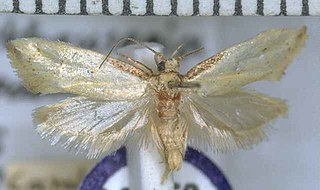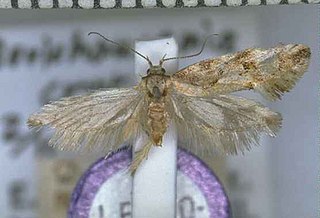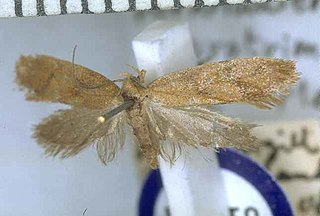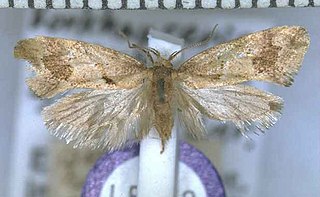
Asterivora colpota is a moth in the family Choreutidae. It was first described by Edward Meyrick in 1911. It is endemic to New Zealand and is found throughout the North and South Islands. It is regarded as a lowland species and adults are on the wing from November until March. This moth has been collected by beating shrubs.

Trachypepla semilauta is a moth of the family Oecophoridae and was first described by Alfred Philpott in 1918. It is endemic to New Zealand and has been collected in Southland. This species inhabits southern beech forest on the side of mountains. Adults are on the wing in January.

Tingena anaema is a species of moth in the family Oecophoridae. It is endemic to New Zealand and has been collected at Lake Wakatipu, Invercargill and Stewart Island / Rakiura. The adults of the species are on the wing in December.

Tingena apanthes is a species of moth in the family Oecophoridae. It is endemic to New Zealand and found in the North Island. The adults are on the wing from October to December. It appears associated with Leptospermum species and it has been hypothesised that the appearance of the adults of this species imitates faded Leptospermum leaves.

Tingena clarkei is a species of moth in the family Oecophoridae. It is endemic to New Zealand and has been observed in the North and South Island. This species is on the wing from November until February and inhabits open scrubland or native forest. This species is similar in appearance to Trachypepla photinella.

Tingena crotala is a species of moth in the family Oecophoridae. It is endemic to New Zealand and is found both in the North and South Islands. This species inhabits native forest and is on the wing in November and December.

Tingena hemimochla is a species of moth in the family Oecophoridae. It is endemic to New Zealand and has been observed in the North Island. Adults of this species are on the wing from December until March.

Tingena homodoxa is a species of moth in the family Oecophoridae. It is endemic to New Zealand and is found in the southern parts of the South Island. It inhabits open grassy slopes and is on the wing from November until January.

Tingena horaea is a species of moth in the family Oecophoridae. It is endemic to New Zealand and have been observed in both the North and South Islands. The adults are on the wing in January.

Tingena letharga is a species of moth in the family Oecophoridae. It is endemic to New Zealand and has been observed in Otago. Adults are on the wing in December and January.

Tingena melanamma is a species of moth in the family Oecophoridae. It is endemic to New Zealand and has been observed in Marlborough, Otago and Southland.

Tingena monodonta is a species of moth in the family Oecophoridae. It is endemic to New Zealand and has been found in both the North and South Islands. This species inhabits native beech forest at altitudes of between 2500 - 3000 ft. The adults of the species are on the wing from November and December.

Tingena paratrimma is a species of moth in the family Oecophoridae. It is endemic to New Zealand and has been observed in the lower parts of the South Island. George Hudson regarded this species are uncommon. The adults of this species are on the wing from November to February.

Tingena penthalea is a species of moth in the family Oecophoridae. It is endemic to New Zealand and has been observed in Wellington and the Tararua Range. The adults of this species are on the wing from December until February.

Tingena pronephela is a species of moth in the family Oecophoridae. It is endemic to New Zealand and is found in the southern parts of the South Island. The species inhabits the outskirts of scrub and native forest. The adults of this species are on the wing from October to February.

Trachypepla galaxias is a moth of the family Oecophoridae first described by Edward Meyrick in 1883. It is endemic to New Zealand and can be found throughout the country. This species inhabits native forest. The life history of this species is currently unknown. Adults are on the wing from October to February, are nocturnal and are attracted to light.

Trachypepla importuna is a moth of the family Oecophoridae first described by Edward Meyrick in 1914. It is endemic to New Zealand. Adults have been collected in the North Island in January but the species is regarded as being poorly known.

Trachypepla leucoplanetis is a moth of the family Oecophoridae first described by Edward Meyrick in 1883. It is endemic to New Zealand and has been collected in both the North and South Islands. It is the smallest moth species in the genus Trachypepla and the patterns on the forewings of adults are variable in appearance. It inhabits native forest and bush and the larvae feed on leaf litter. Adults are on the wing from October until February. T. leucoplanetis is regarded as being rarely observed and has been collected via the beating of foliage.

Trachypepla protochlora is a moth of the family Oecophoridae first described by Edward Meyrick in 1883. It is endemic to New Zealand and is found in both the North and South Islands. The preferred habitat of this species is native forest and adults are on the wing from October until February. Adults can be variable in their green shaded colour as well as in the intensity of markings on their forewings. The greenish ground colouration of this moth ensures they are well camouflaged when at rest on green mosses and lichens.

Orthenches chartularia is a moth of the family Plutellidae first described by Edward Meyrick in 1924. It is endemic to New Zealand and can be found in the North and South Islands. This species inhabits open grassy areas in native subalpine forest. Adults are on the wing in January and February.






















